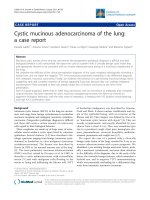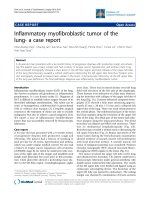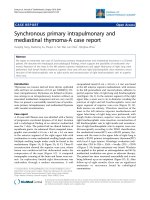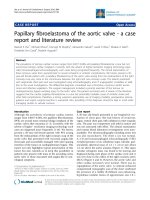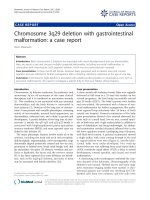Báo cáo y học: "Adverse clinical sequelae after skin branding: a case series" pps
Bạn đang xem bản rút gọn của tài liệu. Xem và tải ngay bản đầy đủ của tài liệu tại đây (567.26 KB, 5 trang )
BioMed Central
Page 1 of 5
(page number not for citation purposes)
Journal of Medical Case Reports
Open Access
Case report
Adverse clinical sequelae after skin branding: a case series
Shahzad Raza*
1
, Khalid Mahmood
2
, Abdul Hakeem
3
, Sylvie Polsky
4
,
Anna Haemel
5
, Soniya Rai
6
and Mahadi Ali Baig
7
Address:
1
Department of Oncology, New York University, NY, USA,
2
Department of Internal Medicine, Dow University of Health Science, Civil
Hospital, Karachi, Pakistan,
3
Department of Cardiology, University of Cincinnati, OH, USA,
4
Massachusetts Institute of Technology, MA, USA,
5
Department of Internal Medicine, University of Wisconsin, WI, USA,
6
Gulf Medical College, Ajman, United Arab Emirates and
7
Department of
Internal Medicine, Montefiore Medical Center, North Division, NY, USA
Email: Shahzad Raza* - ; Khalid Mahmood - ; Abdul Hakeem - ;
Sylvie Polsky - ; Anna Haemel - ; Soniya Rai - ; Mahadi Ali
Baig -
* Corresponding author
Abstract
Introduction: Branding refers to a process whereby third degree burns are inflicted on the skin
with a hot iron rod or metallic object. Branding employs the phenomenon of "counter irritation,"
and is widely used by faith healers in developing countries for therapeutic purposes. Some methods,
which are very crude and inhuman, carry a large risk of complications. The purpose of this study is
to present a series of complications and to familiarize clinicians with this dangerous method of
treatment.
Case presentation: Four Pakistani patients, three male and one female, ranging from 25 to 60
years of age "branded" with a red hot iron rod for various medical reasons presented with severe
medical complications to our tertiary care hospital. The mean duration between the procedure and
presentation to the hospital was 6 days. At the time of admission, two patients had septic shock,
one patient had cavernous sinus thrombosis and one patient had multiple splenic abscesses. All
patients received standard care for wound management and systemic infections. Two patients
eventually died during the course of treatment.
Conclusion: Severe complications from branding are troublesome and the potential risks of this
treatment outweigh its benefits. Globally, there is a great need for heightened awareness about the
dangers of branding among patients and physicians, as this will have an important effect on patients
who seek branding for various medical conditions.
Introduction
Branding refers to a traditional practice of creating 'burns'
on the skin with a hot iron rod or metallic object [1]. In
several Asian and African societies where traditional med-
icine is still the "standard of care," branding continues to
have non standard medical applications [2]. Branding
employs the phenomenon of "counter irritation" which is
the brief use of moderately intense pain to relieve chronic
pain. A variety of methods based on this same principle
have been employed in different cultures. These methods
include cupping (a glass cup is heated by hot coals or
flaming alcohol and inverted onto the painful area), scar-
ification (skin over painful area is cut and allowed to
bleed; this can be coupled with cupping), trepanation
Published: 23 January 2009
Journal of Medical Case Reports 2009, 3:25 doi:10.1186/1752-1947-3-25
Received: 14 June 2008
Accepted: 23 January 2009
This article is available from: />© 2009 Raza et al; licensee BioMed Central Ltd.
This is an Open Access article distributed under the terms of the Creative Commons Attribution License ( />),
which permits unrestricted use, distribution, and reproduction in any medium, provided the original work is properly cited.
Journal of Medical Case Reports 2009, 3:25 />Page 2 of 5
(page number not for citation purposes)
(scraping of the skull for headaches; producing skin abra-
sions on the neck for dental pain) and others [1].
There are various forms of branding which include:
• strike branding
• hypothermal (freeze) branding
• chemical branding
• electrocautery branding
• laser branding
The most common and traditional form of branding is
"Strike branding" which is performed with sheet metal
strips heated by a propane torch (1900 to 2100°F). The
"strike" is performed by applying the heated strip to the
skin. The conglomerate of heated strips forms the desired
pattern on the skin post striking. Hypothermal (freeze)
branding was initially introduced by cattle ranchers as an
alternative method to heat branding. It involves immers-
ing a metallic rod, similar to the metal used in strike
branding, into a solution of liquid nitrogen or another
cooling agent (commonly dry ice 5% in 95% pure alcohol
solution). The metal sheet is then applied to the skin for a
brief period. The branding leaves an indentation at the
site. Sometimes caustic agents are applied directly to
undamaged skin or placed on prior delineated scars from
a striking or hypothermic branding. These ancient meth-
ods are crude and inhumane, causing the treatment to be
more unbearable than the original complaint and carry-
ing a large risk of complications [1-4].
Modern methods of branding as a form of body art
include electrocautery branding, which uses a hot surgical
cautery pen to apply the burn, and laser branding, which
acts by vaporizing tissue in its path [1,3].
Case presentation
Four patients presented to our tertiary care center with
severe infectious complications. All were branded accord-
ing to custom with a hot metal rod. The mean duration
between branding and presentation to the hospital was 6
days. The procedure was done in a local township by faith
healers as part of a cultural practice. At the time of admis-
sion, two patients presented with septic shock, one patient
presented with a cavernous sinus thrombosis and another
presented with multiple splenic abscesses. On examina-
tion all were clearly unwell and were found to have vari-
ous medical conditions such as chronic liver disease,
chronic malaria, acute glaucoma and metastatic
melanoma. They were treated for the burns and wounds
caused by branding and other systemic medical complica-
tions in addition to their pre-existing medical conditions.
Here we discuss the outcome of these patients, including
their treatment and any complications.
Clinical cases
Case 1
A 25-year-old Pakistani male with chronic liver disease
(Hepatitis C positive) underwent branding of the anterior
abdomen with a heated metal rod for severe pain (Figure
1). One week later, he presented with altered mental sta-
tus, high grade fever and multiple round circumscribed
erythematous and indurated lesions on his abdomen
ranging in size from 3 to 5 cm with black eschar and active
drainage. His past medical history was noncontributory
except for hepatitis C, diagnosed 10 years earlier. Ultra-
sound of the abdomen showed massive free fluid with
splenomegaly and a shrunken liver. The ascitic fluid had a
high white cell count (16,000/mm3) with 95% neu-
trophils. He was treated with a 3-week course of intrave-
nous ceftriaxone and topical silver sulfadiazine and sterile
dressings for 2 weeks. The fact that this was the first pres-
entation with hepatic encephalopathy after branding, and
pan sensitive E. Coli grew both from the branding inflicted
skin wounds and ascitic fluid, points towards skin
wounds inflicted by branding as the likely culprit for bac-
terial peritonitis and decompensated cirrhosis.
Case 2
A 35-year-old Pakistani male with a history of chronic
malaria, progressive splenomegaly and a complaint of
severe left sided abdominal pain was treated by branding
with a hot metal rod 7 days prior to admission. A week
later he was admitted for septic shock and severe pain in
the left hypochondrium. Past medical history was non-
Distributed in a circular pattern on the abdomen are round, regularly shaped symmetric necrotic ulcers with black eschar and on the right lower abdomen and extending onto the proximal thigh was a large shallow ulcer with yellow crusting but no frank purulence; all areas of skin breakdown produced by branding with a metal rodFigure 1
Distributed in a circular pattern on the abdomen are
round, regularly shaped symmetric necrotic ulcers
with black eschar and on the right lower abdomen
and extending onto the proximal thigh was a large
shallow ulcer with yellow crusting but no frank puru-
lence; all areas of skin breakdown produced by
branding with a metal rod.
Journal of Medical Case Reports 2009, 3:25 />Page 3 of 5
(page number not for citation purposes)
contributory except for an intermittent low-grade fever
and occasional spikes of a high-grade fever with chills. On
examination, he was disoriented and had multiple circu-
lar full-thickness burns to the anterior abdomen ranging
in size from 2 to 5 cm across with central sparing of the
skin and yellow discharge from the wounds. Blood and
wound cultures grew Staphylococcus aureus. Abdominal
ultrasound on admission showed a massively enlarged
spleen with multiple rounded areas of complex echo-
genicity showing multiple splenic abscesses which were
not seen in previous ultrasounds. He was treated with
broad spectrum antibiotics and silver sulfadiazine. A
splenectomy was performed and a gross examination con-
firmed the existence of multiple splenic abscesses which
were also positive for Staph. aureus. Culture of pus from
the spleen revealed growth of same Staph. aureus that were
present on burn wounds complicated by skin branding.
The patient died in the fourth week during the course of
treatment.
Case 3
A 60-year-old Pakistani male with a history of acute exac-
erbation of open angled glaucoma of the right eye under-
went branding of the right temple and vertex by a faith
healer. Four days later, he presented to the hospital with
blurry vision in the right eye and cellulitis over the right
temporal region. Further examination revealed chemosis,
corneal haziness, severe restriction of ocular movements
and multiple well circumscribed round full-thickness
burns ranging from 2 to 5 cm with no evidence of active
drainage. Fundoscopy showed papilledema and hemor-
rhages with engorgement of veins. On day five, similar
signs appeared in the contralateral eye. His past medical
history was insignificant except for glaucoma. He had no
prior history of sinus headaches or ear infections. Since
local infection is the major reason for cavernous sinus
thrombosis (CST), the diagnosis was suspected in our
patient as the typical sequelae had started after branding.
Acute glaucoma can sometimes present with CST; how-
ever, he was already on treatment for open angled glau-
coma and had no previous infection. The fact that he had
acute exudative wounds after branding and had no prior
history of ear or sinus infections points towards branding
as a cause of CST. Our diagnosis was confirmed by mag-
netic resonance imaging (MRI). We believe this local
inflammation and infection may have spread and reached
one of the cavernous sinuses which may turned into an
infected clot. The patient partially responded to intrave-
nous broad-spectrum antibiotics (Amoxicillin with clavu-
lanic acid and Ceftriaxone) and local wound
management, but suffered permanent blindness.
Case 4
A 55-year-old Pakistani female with metastatic melanoma
underwent branding with a metal rod heated over coal to
multiple sites of cutaneous metastases including the right
ear, angle of the mandible, middle of the neck and left
axillary area (Figure 2). The metallic ash was then rubbed
onto the resulting wounds. Three days later she presented
with fever, tachycardia and hypotension. Physical exami-
nation revealed multiple circular full-thickness burns and
blisters with central sparing ranging in size from 1 to 6 cm
in diameter. The burn margins were erythematous and
indurated. Aggressive management of her burns was per-
formed on an inpatient basis. Broad-spectrum oral antibi-
otics were administered and the wound was treated with
topical silver sulfadiazine and clean dressings. Since nor-
mal skin acts as a defense mechanism in the body, in our
patient, who was already immunocompromised, brand-
ing created third degree burns and breached the intact
skin seeding the metastatic lesions with infection. Blood
and wound cultures grew the same Staphylococcus aureus.
She was started on intravenous vancomycin and levo-
floxacin. Despite aggressive measures, she died in the hos-
pital a week later. Thus, it was either inflicting third degree
burn wounds in our immunocompromised patient, or
wound contamination due to unsterile techniques that
had led to complications in our patient, or a combination
of both.
Results
We have presented four cases of severe complications of
branding. All four patients had undergone branding for
pain attributed to their chronic conditions. Mean dura-
tion between branding and admission to the hospital was
6 days. All patients presented either with acute exacerba-
tion of their chronic conditions or new complications
after branding, which were directly or indirectly associ-
ated with branding. A major complication of skin brand-
ing was local infection, which resulted in septic shock and
was observed in two patients during the second week fol-
Patient with metastatic melanoma presented with multiple areas of branding over the skinFigure 2
Patient with metastatic melanoma presented with
multiple areas of branding over the skin.
Journal of Medical Case Reports 2009, 3:25 />Page 4 of 5
(page number not for citation purposes)
lowing branding, and cavernous sinus thrombosis and
splenic abscesses were seen in the first and third weeks.
Two patients died in hospital, one patient developed per-
manent unilateral blindness and one patient fully recov-
ered during his hospital stay. Six month follow-up was
available only in the one patient who recovered with no
further episodes of hepatic encephalopathy, whereas the
patient with unilateral blindness was lost to follow-up.
Discussion
The study of folk medicine in ancient cultures has revealed
a variety of customs and practices which have survived
until the present day. One of the most common ancient
techniques used for centuries to relieve pain utilizes
"counter irritation" which is the application of a second-
ary man-made irritant to the site of the original injury.
These irritants include, among others, mineral/herbal irri-
tants, massage, firing irons and setons.
In Eastern societies where the practice of modern medi-
cine is inaccessible to a large part of the population,
patients seek branding treatments for many medical con-
ditions such as backache, sciatica, arthritis, paralysis,
facial palsy, ascites, splenomegaly, lymphadenopathy,
jaundice, glaucoma, migraine headaches and sore throat
[4]. Kumar S et al provided a case report of a patient with
progressive weakness who underwent branding [2]. Simi-
larly, Kaatz M et al have described body-modifying con-
cepts and dermatologic problems of its aesthetic use [3].
The role of branding as a body art is recognized; however
its role in disease management or as a subjective control
of pain is unclear [1]. It is proposed that the secondary
inflammatory response to the applied irritant comprising
vasodilation, enzyme release, swelling, edema, blebs, ves-
icles and suppuration may aid leucocytes and opsonins
released in the inflamed area, leading to bacterial destruc-
tion. In addition, this response aids in the rapid elimina-
tion of toxins [1]. These effects alone, however, cannot
explain how counter irritation to the surface of the body
can decidedly affect distant internal organs. The influence
of counter-irritants may be summarized in a reflex action;
for example, the production and conduction of an
impulse from the periphery to nerve centers modifies the
nerve function and blood supply in distant parts [5].
In our case series, faith healers used hot metal rods and
coals for branding. It is hypothesized that skin breakdown
and improper wound care can lead to severe infections.
Thus, local wound infections resulted in exacerbation of
current illness and complications like hepatic encepha-
lopathy, subacute bacterial peritonitis, multiple splenic
abscesses, cavernous sinus thrombosis and systemic bac-
terial sepsis in our cases. It is likely that these procedures
were done in an unsterile procedure resulting in these
complications and therefore carry a larger risk, which out-
weighs the benefits of short-term pain relief (according to
popular belief but without scientific evidence). But severe
medical complications of this procedure and its potential
risks outweigh the benefits of short-term pain relief.
Wound management can be challenging in these patients.
Patients' branded lesions typically look like multiple cir-
cular burns ranging in size from 2 to 5 cm across with cen-
tral sparing of the skin [3] and they are likely to present
complaining of symptoms suggestive of infection. They
have diminished resistance to infection and other external
noxious agents and like any other third degree burns,
parenteral antibiotics fail to penetrate the dead tissue due
to poor blood supply. Treatment includes local irrigation
of the burns with saline solution and gentle debridement
of the eschar if necessary. Infected limbs should be rested
and elevated. Silver sulfadiazine or another appropriate
antimicrobial agent should be applied to the wound as
required [1,3]. If cellulite is present, empiric intravenous
broad spectrum antibiotic coverage should be initiated
(nafcillin, evofloxacin, or cephalosporin) in these
patients. However, the extent of the infection and its loca-
tion help determine what type and route of coverage is
required.
In the long-term, branding procedures can cause disfig-
urement from contractures (especially over joint sur-
faces), scars, hair loss, keloids, orthokeratotic
hyperkeratosis, acanthosis and squamous cell carcinoma
(Marjolin's ulcer). Other medical complications include
foreign body reaction, oral and tooth complications, aspi-
ration and hypoxia, edema and swelling, infections and
viral transmission including hepatitis and HIV [3,6-8].
Branding has recently become more fashionable in West-
ern countries [1,3], where it is increasingly practised as
body art. In these settings branding is usually performed
in safe conditions, or with more precautions against seri-
ous infection, and is not used for counter irritation as it is
in people whose health is already seriously compromised.
Branding in Western society is described as a behavior
associated with a high level of substance use, sexual inter-
course and multiple partners, high risk sexual activity,
smoking, marijuana use, suicidal ideation and suicidal
and homicidal attempts [9-11].
There are two populations with different cultural back-
grounds who seek branding for entirely different reasons.
There is no direct association between the behavior asso-
ciated risk problem in Western populations and the com-
plications seen in our patients. Thus people who seek
branding for body-art do not have the same sequelae of
acute infections because of better sterile techniques. How-
ever, it is unclear whether the use of a sterile procedure in
Publish with BioMed Central and every
scientist can read your work free of charge
"BioMed Central will be the most significant development for
disseminating the results of biomedical research in our lifetime."
Sir Paul Nurse, Cancer Research UK
Your research papers will be:
available free of charge to the entire biomedical community
peer reviewed and published immediately upon acceptance
cited in PubMed and archived on PubMed Central
yours — you keep the copyright
Submit your manuscript here:
/>BioMedcentral
Journal of Medical Case Reports 2009, 3:25 />Page 5 of 5
(page number not for citation purposes)
the chronically ill who seek branding would not still result
in severe local complications. Thus a careful assessment
and discussion of host factors should be an integral aspect
in people who seek branding for various reasons.
Conclusion
This article describes the complications of skin branding
which still has therapeutic uses in some cultural societies.
Severe medical complications of skin branding are worri-
some and these risks far outweigh the benefits of these
procedures. In the present study we have seen complica-
tions without therapeutic benefit, therefore universal rec-
ognition of the complications of skin branding is
necessary among both patients and physicians, as it will
have crucial implications in the management of patients
who seek branding for a variety of medical reasons due to
the lack of availability of modern medical resources.
Consent
We hereby declare that informed consent was obtained
from each subject when the patient presented to the hos-
pital with complications of skin branding. We received
permission for reporting complications, manuscript pub-
lication and photographs.
Competing interests
The authors declare that they have no competing interests.
Authors' contributions
SH contributed to analysis of the data, creation of the con-
ceptual design, literature search, interpretation of results,
and writing of the manuscript. MB also aided in interpret-
ing the results, searching the literature, acquiring data,
and writing the manuscript. KM provided the background
and design of the study and a careful review of the manu-
script. SP revised and edited the final manuscript, SR and
AHD helped with the design of the study, and searched
the literature. AH provided background on the study,
aided in acquisition of data, and helped with the design
and interpretation.
References
1. Karamanoukian R, Ukatu C, Lee E, Hyman J, Sundine M, Kobayashi M,
Evans GR: Aesthetic skin branding: a novel form of body art
with adverse clinical sequela. J Burn Care Res 2006, 27:108-110.
2. Kumar S, Kumar PR: Skin branding. J Postgrad Med 2004, 50:204.
3. Kaatz M, Elsner P, Bauer A: Body-modifying concepts and der-
matologic problems: tattooing and piercing. Clin Dermatol
2008, 26:35-44.
4. Wand-Tetley JI: Historical methods of counter-irritation. Ann
Phys Med 1956, 3:90-99.
5. LaMotte RH, Thalhammer JG, Torebj Auork HE, Robinson CJ:
Peripheral neural mechanisms of cutaneous hyperalgesia fol-
lowing mild injury by heat. J Neurosci 1982, 2:765-781.
6. Tweeten SS, Rickman LS: Infectious complications of body
piercing. Clin Infect Dis 1999, 26:735-740.
7. Pugatch D, Mileno M, Rich JD: Possible transmission of human
immuno-deficiency virus type 1 from body piercing. Clin Infect
Dis 1998, 26:767-768.
8. Hayes M, Harkness G: Body piercing as a risk factor for viral
hepatitis: An integrative research review. Am J Infect Control
2001, 29:271-274.
9. Kann L, Kinchen SA, Williams BI, Ross JG, Lowry R, Grunbaum JA,
Kolbe LJ: Youth Risk Behavior Surveillance – United States,
1999. State and local YRBSS Coordinators. J Sch Health 2000,
70:271-285.
10. Martin A: On teenagers and tattoos. J Am Acad Child Adolesc Psy-
chiatry 1997, 36:860-861.
11. Brooks TL, Woods ER, Knight JR, Shrier LA: Body modification
and substance use in adolescents: is there a link? J Adolesc
Health 2003, 32:44-49.

